Barcelona are going through tough times. After their first trophyless season since 2008, the Catalan giants have started the season in bad form, getting just 14 points in their first 10 La Liga games and finishing second to Juventus in their UEFA Champions League group.
After a chaotic summer in which Lionel Messi tried to leave the club and without any exciting signings, Barcelona are cash-strapped and won’t elect their new president until late January, so it will be difficult to sign a superstar who can rebuild the team. But they do have a good academy, one of the best in the past decade, and some interesting players loaned to other clubs who could come back and make an impact in the first team.
In this data analysis, we will look at how the players Barcelona have loaned out are performing and what chances they have to come back to the first team next season.
Emerson Royal
Emerson was bought by Barcelona for 12 million euros in the summer of 2019 but has been on loan to Real Betis since then. The Brazilian 21-year-old right-back has already played 50 games for Betis in less than 18 months and could be an option to strengthen Barcelona’s defence in a position where the only natural player is Sergiño Dest.
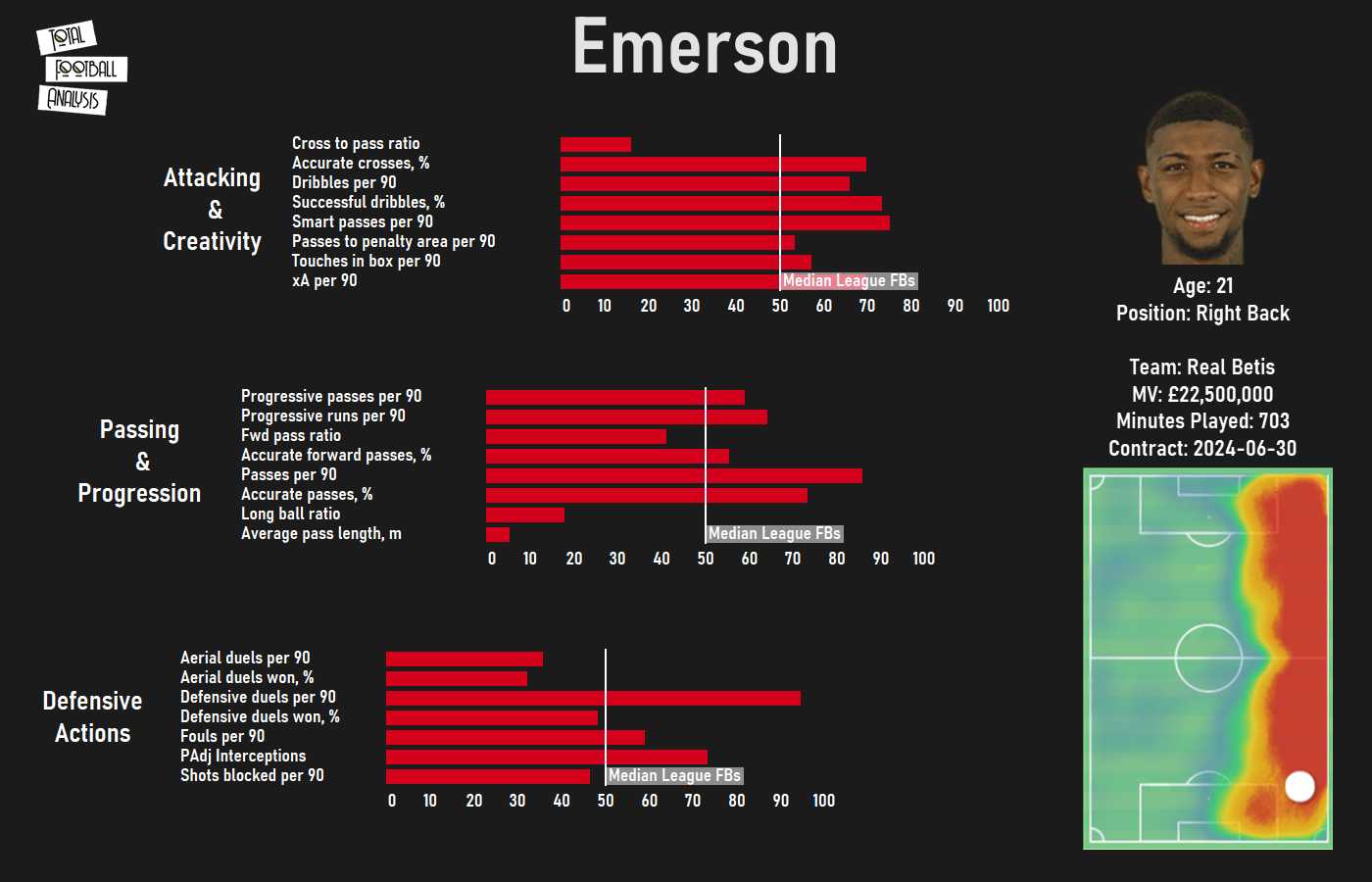
Looking at his statistics, we can see why Barcelona consider Emerson a long-term investment. Playing for a possession-based side like Pellegrini’s Real Betis, Emerson’s main strengths lay in his attacking output.
He’s above the majority of La Liga full-backs in most attacking metrics. Emerson is a modern full-back capable of creating chances by himself with a great dribbling ability and the stamina to be ever-present in the final third. He attempts lots of dribbles (2.56 per 90) and completes more than most of the full-backs (70%), which would be something very useful for Barcelona’s tactics.
He’s also in the top 30% of La Liga full-backs when it comes to expected assist with 0.11 per 90. Emerson can cross or pass the ball into dangerous zones, and despite not crossing a lot (his cross to pass ratio is very low) and passing an almost average number of balls into the box, his crosses and passes are very accurate and aimed to good spots inside the box, often resulting in threatening shots.
Emerson’s passing profile also fits what Barcelona could expect. He usually makes short and lateral passes, aiming to keep possession unless he has a clear chance to go forward. In his heatmap, we see he can also come inside and gets very involved in the game with 53.6 passes per 90, one of the highest in La Liga. He’s also good but not outstanding when progressing the ball, especially through runs using his great athletic conditions. He has 8.45 progressive passes and 1.41 progressive runs per 90 so far this season, both of them in the top 50% of La Liga full-backs.
Defending is probably Emerson’s weakest spot. He gets involved in lots of duels (9.86 per 90), is capable of pressing high but also leaves his position unnecessarily some times. He’s an ok defender, winning a close-to-average percentage of his defensive duels (58.44%) but also committing many fouls. He uses his pace to recover and intercept passes and crosses but could improve in the air, especially considering he stands at 183 cm / 6’0’’.
The right-back position is one where talent isn’t easily found in today’s football and Barcelona would find it difficult to find a much better player than Emerson in that position despite not being a superstar. He should have the chance to come back to Barcelona as a backup to Dest and move Sergi Roberto to his natural central midfield position. It would be a cheap option and he has already shown he’s a good player at this level. However, being a non-EU player could harm his options.
Moussa Wagué
Moussa Wagué has found it difficult to find his place so far in his career. The 22-year-old full-back came through the prestigious ASPIRE Academy in Qatar and spent half a season in Belgium before signing for Barcelona in 2018 for 5 million euros. After spending a season in the B team and without many chances in the first team, Wagué joined Nice on loan and enjoyed some minutes before the Ligue 1 was cancelled due to COVID-19. This season, Moussa is on loan at PAOK in Greece and after a doubtful start, he’s starting to get playing time.
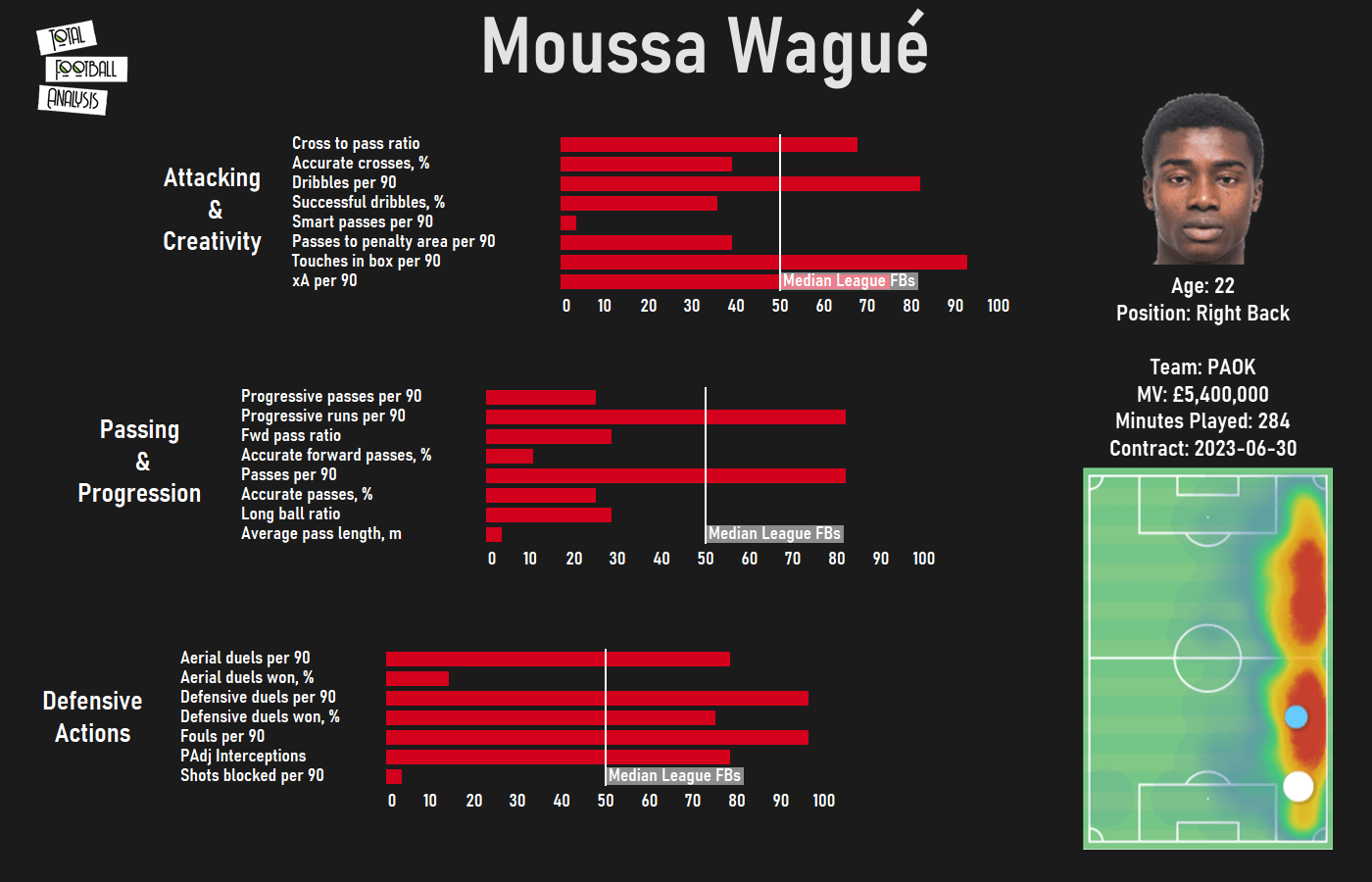
The first thing we notice in Wagué’s heatmap is that he stays much closer to the touchline than Emerson. Wagué is a very quick and physical full-back but doesn’t have as much creativity or passing quality as the Brazilian, so he bases his game more on his pace and dribbling than on combinations.
As we have said, Wagué’s main strength is his pace and he uses it to progress and dribble very often. With 3.17 attempted dribbles and 1.9 progressive runs per 90, he’s among the best full-backs in the Greek SuperLeague in these metrics.
But when we look at his ball-playing abilities, Wagué doesn’t look like a full-back who could fit possession-based tactics like Barcelona’s. He’s very involved in the game (42.15 passes per 90) because he plays in a dominant team like PAOK, but his passing accuracy is very poor (72.93%) and he’s a liability when building the attacks. However, once he gets in the final third he will try to put the ball into the box all the time, averaging 3.49 crosses and 2.54 passes to the penalty area per 90, so he still gets 0.09 xA per 90 which is good for a full-back.
On the defensive side, Wagué is an intense and aggressive defender who’s difficult to beat thanks to his physical attributes. He gets involved in more defensive duels than most of the full-backs (14.26 per 90) and wins a great percentage of them (66.67%), but also commits too many fouls. He also tries to fight in the air and isn’t afraid of getting involved in aerial duels, but he’s not tall enough to win them and it’s something he needs to work on.
Wagué looks like a promising full-back, but his career has a descending trajectory since arriving at Barcelona. If he gets regular playing time at PAOK he could still get a loan or a permanent move to a bigger team or league next season, but he doesn’t seem to fit at Barcelona and they would only keep him if they were desperate for a free backup option.
Monchu
After more than eight years in La Masía, Monchu’s exit from Barcelona has been hard to swallow for many fans. Last season he captained and was the top goalscorer of a Barcelona B side that almost got promoted to Segunda División and he was expected to be part of the first-team squad this season. But instead of that, Barcelona have signed Miralem Pjanic and Monchu had to leave to fellow Catalan team Girona in Segunda División. What’s even worse is that Girona will buy him for just 3.5 million euros if he plays 22 matches and at the moment of writing he has already played 15.
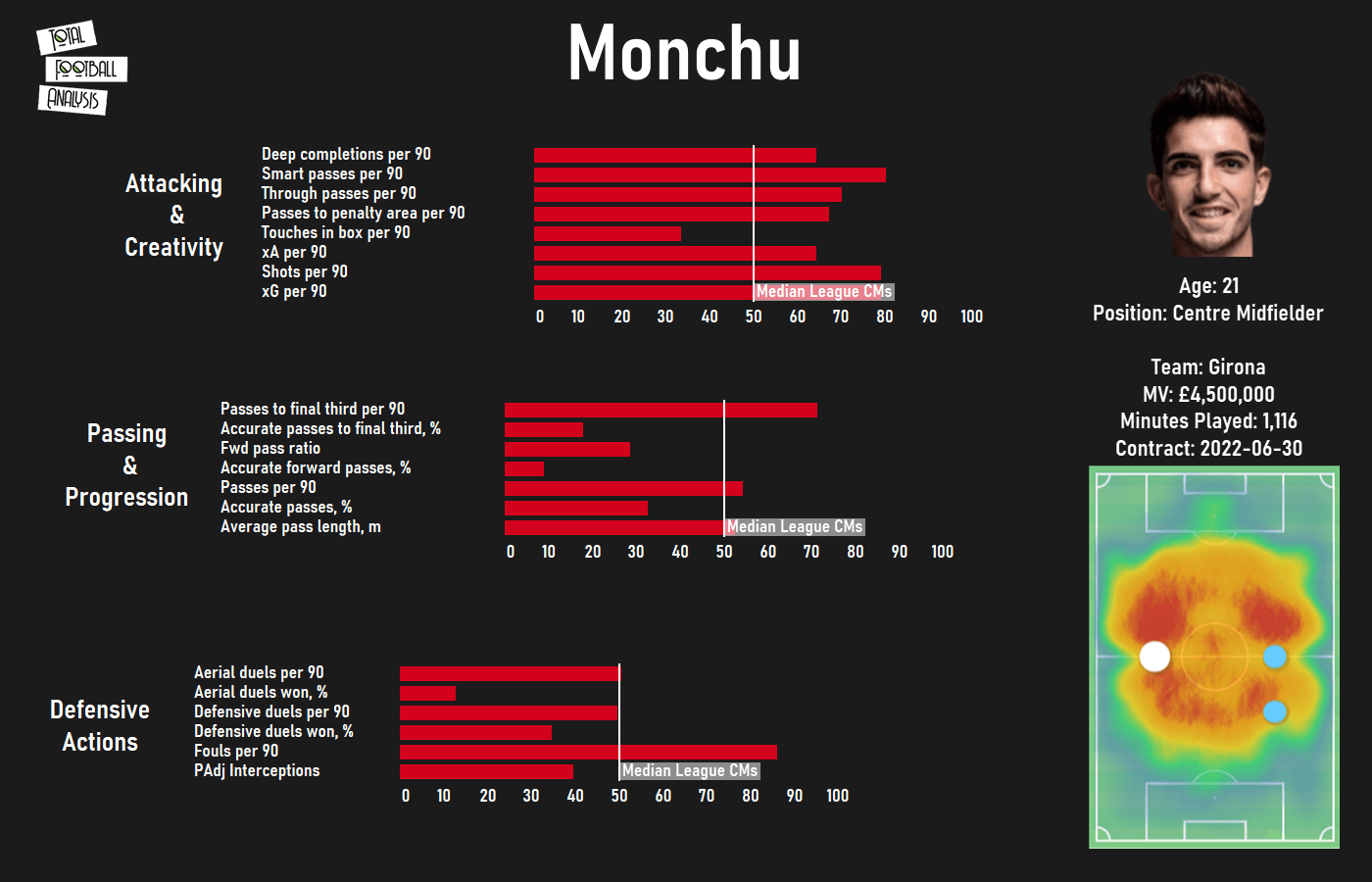
Coming from the academy, Monchu is a player who fits Barcelona. He combines a good presence in midfield and a very good work rate, being capable of covering a lot of ground as we can see in his heatmap, with excellent passing skills, especially in the final third.
Girona have deployed Monchu closer to the goal and he has responded with excellent performances in and around the final third. He’s above the majority of the central midfielders in the Segunda División in expected assists and goals, shots, passes to the penalty area, through passes, smart passes and deep completions per 90. His excellent passing range, creativity and shooting ability make him a player capable of creating things from midfield. With 1.21 shots and 0.1 xG per 90, Monchu is a real threat considering he’s a central midfielder. If we add his 1.53 passes to the penalty area and his 0.06 expect assists per 90, Monchu guarantees a good number of goal contributions every season.
But getting closer to the goal means Monchu doesn’t participate in the buildup as much as he did at Barcelona B. He’s just above the median in passes per 90 with 39.03 and his accuracy should be better for a Barcelona-developed player (82.23%). However, this low accuracy can be explained because he’s attempting more direct passes (18.86 meters is his average pass length), lots of them aimed to the final third (7.26 per 90). He will surely improve as he adapts to a higher level of football.
In defence, Monchu is finding it difficult to make an impact. He does work hard and gets involved in a decent number of defensive and aerial duels (6.61 and 3.47 per 90 respectively) but he struggles to win them (54.88% and 20.23% winning rate) and also commits too many fouls. Again, he needs to adapt to a very different way of playing than he’s used to and to a higher level, especially if he stays at Girona next season.
Monchu seemed an obvious choice to be a backup player at Barcelona this season, but different football and non-football issues have resulted in him playing in Segunda División. He will probably sign permanently for Girona but in case he doesn’t he surely deserves a chance at Barcelona, where he would probably adapt quicker as he knows the playing style and what’s expected from him.
Sergio Akieme
Barcelona have another full-back, this time left-sided, in Sergio Akieme. Like Monchu, Akieme is loaned to a Segunda División side, Almería, and has a buying option of 3.5 million euros. After coming through the academy at Rayo Vallecano, Akieme signed for Barcelona in 2019 for 300,000 euros to play in their B team, but after one season in which he didn’t get any first-team opportunities, he has left on loan as he’s no longer an under-23 player who can move freely between the B and first team. Aged 23, Akieme is getting closer to his peak.
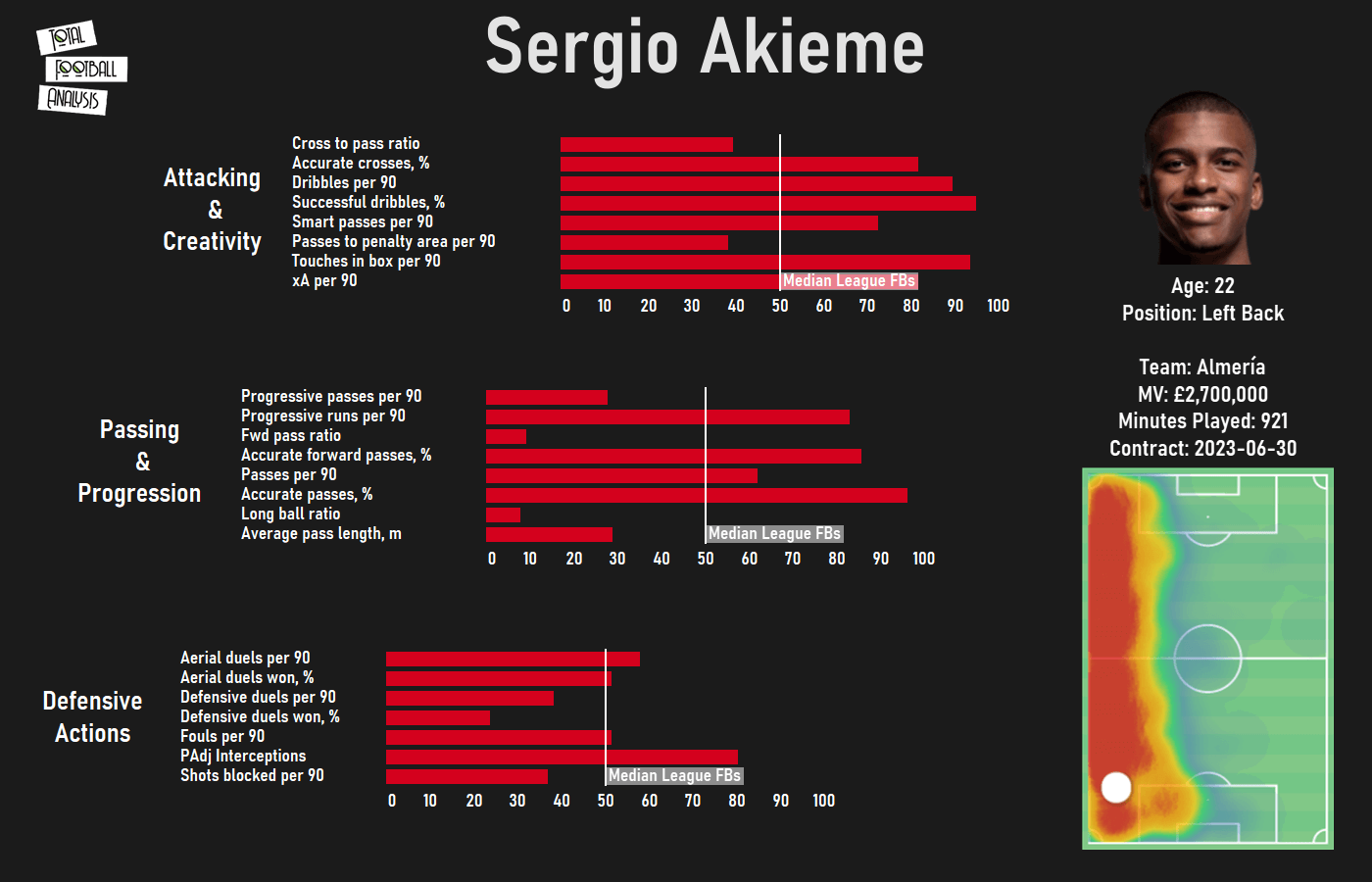
Akieme is a left-back with a good mix of physical and technical conditions. He can cover the whole wing but also drift inside when needed and is very active to defend inside the box. Last season he adapted well to Barcelona B’s playing style and could potentially fit what the first team look for in a left-back.
In possession, Akieme usually plays shorter and safe passes, with a passing accuracy of 84.31%, better than 96% of the Segunda División full-backs. However, he mostly plays sideways and only risks the ball when he knows he will get something. This good decision-making explains his low progressive and into the final third passes. But once he sees the opportunity, Akieme has the quality to assist, averaging a cross accuracy of 44.44% and 0.11 expected assists per 90, both in the top 20% of the Segunda División full-backs.
He can also use his pace to beat his man very effectively, be it with spaces in front of him (2.05 progressive runs per 90, top 17.8%) or in tight spaces (3.62 dribbles per 90 with an 81.08% success rate, better than 89.4% and 94.7% respectively). This ability on the ball and his attacking tendency makes him get into the box often to create danger from there, standing out in touches in the box per 90 with 1.17 (top 5.3%).
On the defensive side, Akieme needs to improve. He’s good at intercepting the ball thanks to his good positioning and his willingness to cover the back of the centre-backs inside his box (8.6 possession-adjusted interceptions per 90, top 20%), but he struggles in defensive duels, winning just 55.22% of them. He’s ok in the air, especially considering he’s not tall standing at 175 cm / 5’9’’.
It seems difficult that Akieme can come back to Barcelona and get a spot in the first team. He could be an ok cover for Jordi Alba and a much cheaper alternative to Junior Firpo, but he hasn’t stood out at the highest level so far in his career and would be a risky choice. He does fit the profile and Barcelona’s tactics and has shown good adaptability while playing for the B team, so there’s still a chance he can be considered but the most likely option is that he gets a permanent move next summer.
Ludovit Reis
Ludovit Reis was a strange signing for Barcelona from the first minute. The 2000-born central midfielder made his debut for Groningen aged just 17 and he became an important player for the Eredivisie side very quickly. However, his playing style doesn’t fit the usual Barcelona midfielder as he’s an intense, hard-working and aggressive midfielder with decent ball-playing ability but not real quality to create. Anyway, Barcelona played 3.25 million euros for him last summer and he was an important part of Barcelona B last season, but couldn’t get into the first team and left on loan to 2.Bundesliga side Osnabrück to continue his development.
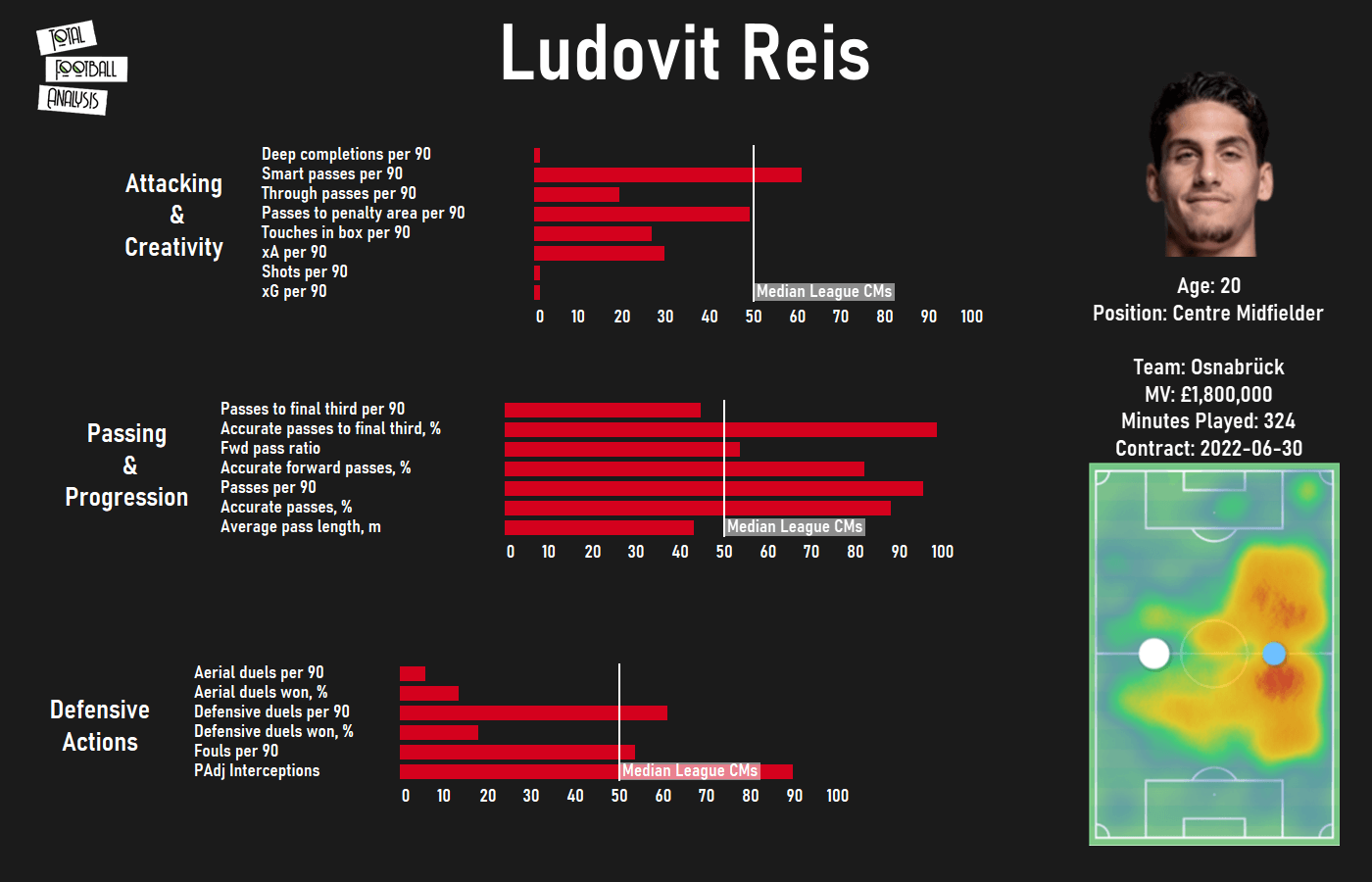
As we can see in his heatmap, Reis is a midfielder who can cover lots of ground even in a physical league like the 2.Bundesliga. The Dutch midfielder can be deployed as a defensive or central midfielder and has a good and balanced playing style that can fit any tactics, especially because of his maturity and attitude on the pitch.
As we have mentioned before, Reis doesn’t stand out as a creative force and he ranks in the bottom 50% of the 2.Bundesliga central midfielders in most attacking and creative metrics. His inability to play through passes (just 0.28 per 90) or create scoring opportunities (0.03 expected assists per 90) wouldn’t fit in a team like Barcelona. He’s just starting his journey in Germany and as he gets more playing time this data could improve, but after seven matches they’re rather worrying.
He’s much better when he gets the ball in deeper positions as he’s decent in his distribution and has learnt a lot while at Barcelona. He’s very involved in the buildup (52.89 passes per 90, top 39.2%) and even if he plays lots of passes forward, he still maintains a very high passing accuracy (87.11%, top 12%), especially when he plays very directly and into the final third (93.33%, top 1.5%). These are promising signals and if he can translate this good passing into creating goalscoring opportunities, his value would increase dramatically.
In defence, Reis is still adapting to a higher level of football. He tries to be everywhere, intercepts lots of passes (8.46 possession-adjusted interceptions per 90, top 10.5%) and gets involved in lots of defensive duels (6.67 per 90, top 38.9%) but struggles to win them (just 50% success rate, only better than 17.9% of the 2.Bundesliga midfielders) and just makes it difficult for the rival to progress without recovering the ball.
We started this section on the analysis by saying Reis didn’t fit at Barcelona and his performance for Osnabrück so far doesn’t say the opposite. He’s a good player with massive potential, but unless he changes his playing style and gets much more creative he will only be able to develop that potential in a different playing style. Given he’s just 20, Barcelona could keep him and loan him again to check his development, but if a good offer comes in, the culés will probably cash in on him.
Josep Busquets
The last one in our data analysis is probably the lesser-known for most of the public. Josep Jaume Busquets is a 19-year-old left-footed centre-back who has been at Barcelona for the last five years. He should have been at Barcelona B this season, but he’s been loaned out to a Segunda B (third tier) club, CF Badalona. He featured for Spain U16 and U17 in the past but hasn’t progressed further.
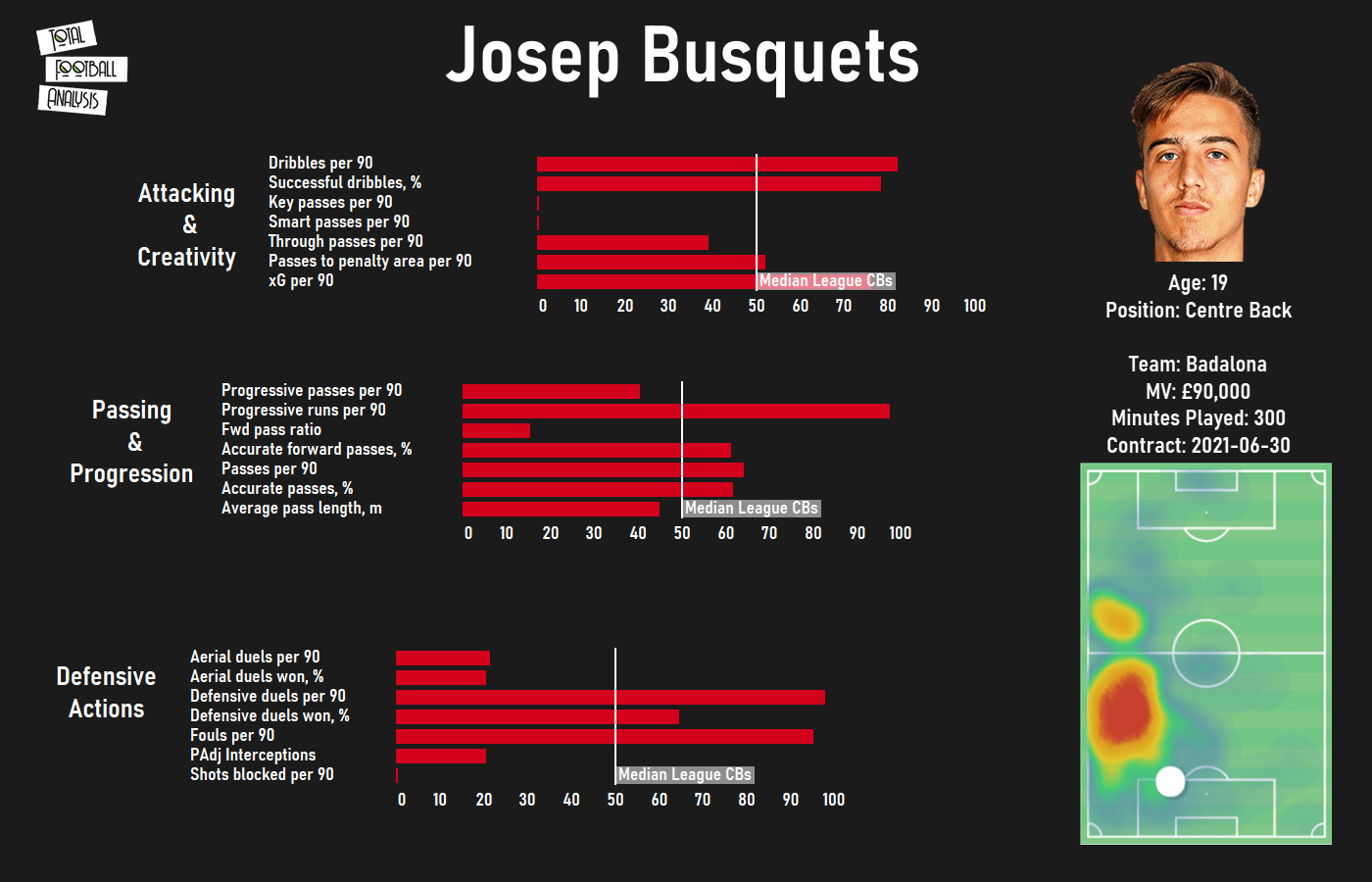
Busquets stands at only 181 cm / 5’11’’, which isn’t great for a centre-back. This season he’s been deployed as a left centre-back in a back-three, probably his best position given his height. He has shown some interesting and rare characteristics for a centre-back that we will analyse now.
On the ball, Busquets is a mix of a centre-back and a full-back. He’s very confident and skilled to drive the ball forward from the back and is a good solution for his team to break the first pressing line. He has 0.9 dribbles per 90 so far with a great success rate and his 2.4 progressive runs per 90 are top 3.6% among the Segunda B centre-backs.
When it comes to passing the ball, Busquets is just ok. His passing accuracy is better than the majority but not great (83.92%) and he doesn’t play many passes forward, preferring to move the ball around until he has space to run.
In defence, his height is a handicap and he knows it, so he gets involved in few aerial duels (just 3.3 per 90, bottom 21.5%) and wins a very low percentage of them (45.45%, bottom 20.6%). Barcelona can afford to play with centre-backs who are not great in the air, but he still needs to improve to make an impact elsewhere. When it comes to ground challenges, Busquets is a very good defender. Playing in a back-three he gets the freedom to leave his position and get involved in lots of defensive duels (9 per 90, top 2.2%) and wins a good share of them (73.33% top 35.4%). He’s quick and aggressive enough to play in a high line and has the confidence to do so from his years at La Masía.
He’s still very young and if he does well, Busquets could still have some future at Barcelona. Being loaned out before making his debut for the B side means he needs to impress to continue at the club, but the lack of left-footed centre-backs and his interesting abilities on the ball make him one to monitor. The most probable is that he won’t feature for the first team soon, but he still has time to develop his game and push for an opportunity.
Jean-Clair Todibo and Juan Miranda
These two haven’t played enough to make a proper analysis of their performances. Todibo was on loan at Benfica but hasn’t played a single minute because of injuries but also because of Jorge Jesús not liking him and he will come back to Barcelona in January. Ironically, the worst loan of all could be the one who gets a first-team opportunity sooner as Barcelona are desperate for a centre-back and probably won’t have the cash to get one in the January market, so Todibo could be an emergency fit.
Juan Miranda has played just 23 minutes so far for Real Betis and doesn’t seem to be a player Pellegrini trusts in. He had the same experience last season at Schalke 04 and despite his young age (20), he needs to play matches to continue his development and push for a first-team opportunity. If things don’t change in the next few weeks, Barcelona could call him back and play him in the B team or try to find another loan to make sure he plays.
Conclusion
When we look at the near future, Barcelona don’t have a lot of players on loan who can make an impact soon. Only Emerson seems ready to be part of the first team, with Monchu being an interesting option that will probably leave on a permanent before the end of the season.
Some first-team young players like Carles Aleñá, Riqui Puig, Matheus Fernandes or Konrad De dtatsLa Fuenteneed need playing time and they could look for a loan option to continue their development and come back stronger next season. Historically, Barcelona haven’t benefited too much from the loan system, being this something the next board should look to improve.
All player profiles in this piece were created by the wonderful Sathish Prasad (@SathishPrasadVT on Twitter). Go check out his stuff!





Comments